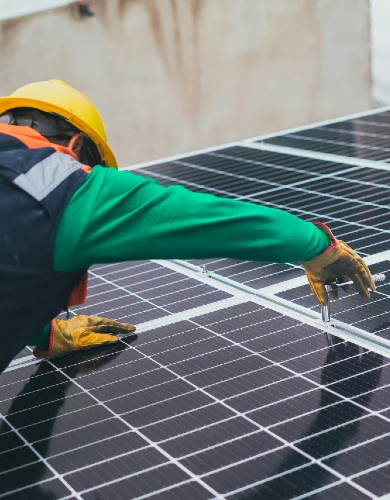Business energy monitoring
The rollout of smart meters in Britain presents a valuable opportunity for businesses to leverage real-time energy consumption data to enhance their operations.
Business energy monitoring systems utilise automatic meter readings to provide insights and visualisations that help businesses improve energy efficiency, optimise energy costs, forecast future bills, and report on carbon emissions.
In this complete guide to monitoring systems, we cover:
- What is business energy monitoring?
- Key features and insights of business energy monitoring
- The benefits of business energy monitoring
- Types of business energy monitoring systems
- How to monitor business energy consumption
- Who offers business energy monitoring services?
What is business energy monitoring?
Business energy monitoring is the process of using smart meter data to track and analyse commercial energy consumption.
To explain how business energy monitoring works, we’ll begin by outlining the three key steps involved in providing real-time energy consumption insights.
Measuring energy usage
Energy monitoring systems receive real-time measurements of electricity and gas consumption from the following devices:
- Smart business energy meters – Modern commercial gas and business electricity meters configured to provide automatic meter readings as frequently as every 15 minutes.
- Half-hourly business electricity meters – These meters provide automatic readings every 30 minutes.
- Advanced business gas meters – Business gas meters that automatically transmit half-hourly meter readings.
- Sub-meters – Specially installed meters and sensors designed to measure energy usage by specific energy-intensive processes.
Data communication
Business energy monitoring systems rely on a centralised platform aggregating real-time consumption data.
Modern monitoring systems are typically cloud-based, with data processing occurring off-site.
Each energy meter transmits meter readings wirelessly, sending the data over the internet using a 4G or WiFi connection.
Data processing and reporting
Energy monitoring systems use analytics software and machine learning algorithms to transform raw energy data into useful insights.
The data is presented in easy-to-understand reports and dashboards.
Key features and insights of business energy monitoring
This section summarises the key features and insights a monitoring system can provide to illustrate the power of business energy monitoring.
Data visualisation
Monitoring systems humanise real-time energy consumption data by presenting it in an easy-to-understand format. Here are some typical examples:
- Energy usage line graphs – Show real-time vs. historical consumption trends.
- Energy usage bar graphs – Compare energy use by site or department.
- Cost change graphs – Visualise billing trends and the impact of energy price changes.
Automatic reporting
Monitoring systems generate and send automatic reports that help you understand and optimise energy consumption. Here are some popular examples:
- Energy consumption reports – Customisable regular reports that compare past and present energy usage by site.
- Energy cost analysis – A breakdown of monthly energy costs by individual sites and departments.
- Billing forecasting – Automatic forecasting of future energy costs to help businesses build financial budgets.
- Carbon footprint reporting – Measures the carbon emissions associated with power and gas consumption for mandatory carbon reporting.
Alerts and notifications
Business energy monitoring systems can provide the following event-driven alerts:
- Real-time alerts – Uses machine learning to detect unusual energy spikes or system failures, triggering an alert.
- Maximum demand alerts – Notifies users when maximum demand exceeds the Maximum Import Capacity on an individual business electricity connection.
- Equipment failure detection – Identifies malfunctioning machinery based on energy anomalies.
Benchmarking
A business energy monitoring system can compare current consumption to identify ways to improve business energy efficiency. Here are some typical benchmarking insights:
- Site-by-site comparison – Compare the energy consumption of different properties in your portfolio to identify anomalies and energy-saving opportunities.
- Year-by-year comparison – Compare a site’s energy consumption against previous years to measure the impact of energy-saving initiatives.
- Energy intensity ratios – Measures business-specific energy intensity ratios, such as consumption per unit of production or per customer served, to provide enhanced site-by-site or year-by-year comparisons.
- Industry benchmarks – Compare your consumption against industry-standard benchmarks.
The benefits of business energy monitoring
A business energy monitoring system provides real-time insights into how your business consumes electricity and gas.
These insights can deliver several important benefits to your business:
Encouraging efficient energy usage
Business energy monitoring systems offer real-time energy usage insights, helping staff remain aware that their actions directly impact energy consumption.
Viewing real-time data on energy consumption encourages simple steps, such as switching off computers and lights at the end of the day.
Reducing business energy costs
Insights from business energy monitoring can directly reduce energy costs in three ways:
- Efficiency savings – Every kWh of energy saved through improved efficiency translates into lower commercial gas rates or business electricity prices.
- Flexing energy consumption – Live reporting of energy costs allows you to adjust energy consumption to cheaper off-peak periods in your business energy contract and use schemes like the demand flexibility service.
- Demand optimisation – Business energy monitoring records half-hourly demand data at your sites. This enables you to monitor maximum demand against your agreed-upon electricity connection capacity to avoid excess capacity charges.
Energy cost reporting and forecasting
Monthly business electricity and business gas bills fluctuate with energy consumption.
Business energy monitoring software provides monthly historical cost analysis, enabling accurate forecasting of site-by-site future energy costs.
Accurate energy forecasting is essential for successfully executing a business energy procurement strategy.
ESG and carbon reporting
Business energy monitoring software offers various sustainability analysis reports.
Business energy monitors measure and report the carbon footprint associated with your electricity and gas supply.
Carbon footprint reports help businesses assess the environmental impact of sustainability initiatives and can directly inform mandatory emission reporting requirements for large businesses.
Monitoring software can also provide a live view of renewable energy sold to the grid under the Smart Export Guarantee scheme.
Types of business energy monitoring systems
This section outlines the main types of business energy monitoring systems available to British businesses.
These systems can be provided either directly by a business energy supplier or by a third-party monitoring service. Find out who offers business energy monitoring services below.
Smart meter-based monitoring
By the end of 2025, all small commercial properties should have a smart meter installed for their business gas and electricity connections.
Smart meter-based monitoring utilises real-time consumption data from these meters.
Smart meter-based monitoring is the simplest type of business energy monitoring system and is offered free of charge by many energy suppliers through their websites.
Business energy monitor display unit
Energy monitoring display units offer a simple solution for small business energy customers, such as hairdressers and newsagents.
An energy monitor unit has a digital display that shows electricity and gas consumption, along with a few predefined graphs that allow you to track consumption at a single property.
Most energy suppliers include energy monitor units free of charge in domestic energy packages, but businesses typically have to purchase them separately.
Energy Management Systems
Energy Management Systems are monitoring systems that use real-time energy consumption data to control and optimise complex energy systems.
A common example is directing electricity generated from commercial solar panels between solar batteries and on-site usage, depending on whether it is a peak or off-peak period in a multi-rate business energy tariff.
Read our guide to Energy Management Systems for businesses to learn more.
Industrial Energy Monitoring Systems
Industrial Energy Monitoring Systems are used by large business energy customers and are designed to provide a more detailed view of energy consumption.
Industrial Energy Monitoring uses sub-meters and IoT sensors installed at the department, production line, or machine level to deliver granular energy consumption data.
Industrial Energy Monitoring Systems can generate automated alerts for unexpected spikes in energy usage, enabling teams to identify and address equipment malfunctions quickly.
Enterprise Energy Management Systems
Enterprise Energy Management (EEM) Systems are designed for businesses with large property portfolios.
EEM Systems collect data centrally and offer real-time monitoring of gas and electricity consumption across hundreds of properties simultaneously.
An EEM System enables large businesses to understand, optimise, and budget their energy expenditure.
Large organisations use EEM Systems to comply with the Energy Savings Opportunities Scheme and to calculate the Energy Performance Certificates (EPCs) of individual properties.
How to monitor business energy consumption
In this section, we’ll explain how to set up a business energy monitoring system to help your company track and manage business energy usage.
Step 1. Identify monitoring requirements
Before setting up an energy monitoring system for your business, it is essential to consider which aspects of your operations consume the most energy to prioritise monitoring efforts.
We recommend gathering recent bills for all MPANs and MPRNs used by your business to understand which locations or activities consume the most energy.
A formal approach to identifying the most energy-intensive activities for larger businesses is to conduct a business energy audit.
Step 2. Install monitoring equipment
Next, consider whether your business has the necessary metering equipment to provide real-time monitoring of energy consumption at the priority sites identified in Step 1.
The most cost-effective way to achieve real-time monitoring is to request a free smart business energy meter upgrade from your supplier.
It may be worth considering dedicated sensors and sub-meters for more complex energy systems to isolate energy consumption measurements for particular machinery.
Step 3: Setup energy monitoring software
The final step is to set up energy monitoring software to automatically receive, analyse, and report real-time consumption data from your monitoring equipment.
The setup process will depend on whether you choose the monitoring software offered by your energy provider (who will already receive smart meter data) or opt for a third-party provider.
Who offers business energy monitoring services?
Business energy monitoring systems are available from energy suppliers and dedicated monitoring providers.
This section explores both options for obtaining a business energy monitoring service.
Energy monitoring services from your business energy supplier
The best business energy suppliers offer energy monitoring services to their customers.
Business energy suppliers already receive automatic meter reading data from your properties, so no setup is required.
- EDF Business Energy – The Energy View system is available to existing customers through their online portal.
- SSE Business Energy – The SSE Clarity System is an energy management platform provided free of charge with all their business energy tariffs.
- British Gas Business Energy – Energy 360 DataView is a free platform that provides business customers with a view of their consumption data.
Use our business energy comparison service to discuss switching business energy suppliers to one that offers free business energy monitoring software.
Third-party energy monitoring service
Multi-site businesses with multiple energy suppliers or a large property portfolio should consider using a dedicated third-party energy monitoring service.
A third-party monitoring service provides sensors that attach to your existing meters, allowing energy consumption to be monitored independently.
Third-party energy monitoring services can also supply sub-meters and other smart sensors to offer a more detailed view of business energy usage.
Business energy monitors – FAQs
Our business energy experts answer frequently asked questions about business energy monitoring.
What’s the difference between a business energy monitor and a smart meter?
A smart meter is a physical device that measures your gas or electricity consumption and automatically transmits meter readings.
A business energy monitor provides insights into energy consumption using smart meter data.
Put simply, a smart business energy meter measures electricity or gas usage, whereas a business energy monitor analyses and presents data insights about energy usage.
Do I need a business energy monitor if I have a smart meter?
No, business energy monitors are not a requirement. Smart meters are usually installed out of sight in a riser cupboard.
They automatically transmit consumption data to your energy supplier, who uses it to generate your commercial gas and business electricity bills.
Businesses may choose to monitor their energy usage simply through their monthly energy bills.
Compare business electricity prices today, and our experts will help you find the best tariffs currently available on the market.

